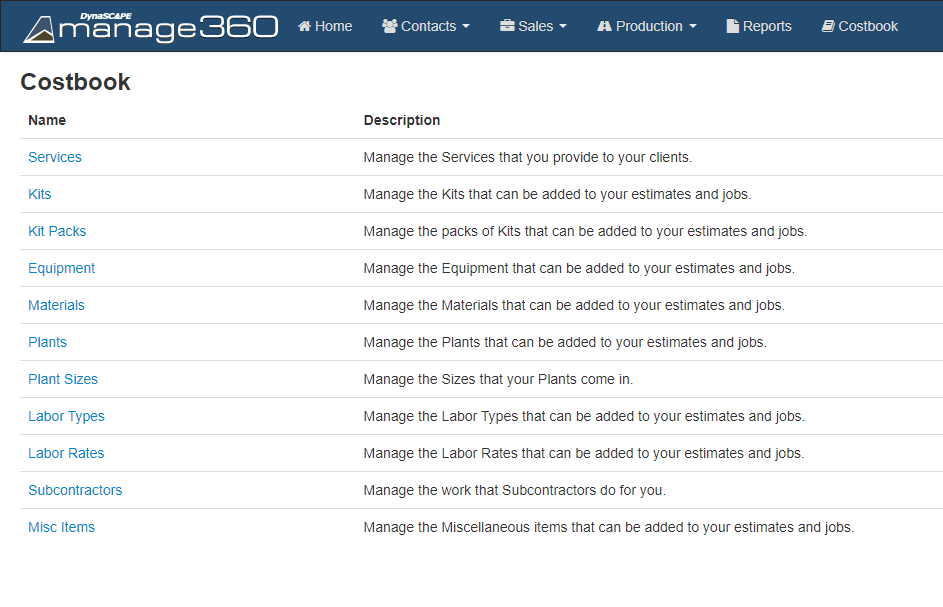

Overview of Costbook Items
A short review of the Costbook Items is provided below; this information will assist you in understanding what each Costbook Item performs and how it impacts estimation.
Services are for maintenance only, and if you are not using Manage360 for maintenance work, then you do not need to build services. A service defines what you will do on a single maintenance visit, and typical examples of services include recurring mow & trim, weeding, fertilization, cleanups, irrigation startup and shutdown, and snow removal. Services will be covered in more detail in an upcoming slide.
Kits (sometimes known as assemblies) are an important tool used to increase the speed, efficiency, and accuracy of your estimating. They are essentially a way for you to group multiple related line items together, so they can be added all at once to an estimate instead of one by one. These line items can have production rates or ratios assigned to them, so that the amount of a line item has a direct relationship with the amount of kit you are adding - for example, adding 100sqft of a 3" mulching kit could bring along 1CY of mulch and an hour of labor.
Other examples of typical kits include mowing, retaining wall, patio install, and fertilization application. Kits can be used on construction estimates, added to maintenance services, as well as T&M non-contract work orders. Kits will be covered in more detail in an upcoming slide.
Kit Packs are a way to create groups of related kits, so that you can add more than one kit to an estimate at a time. For example, you could create a Patio Install kit pack that includes kits for installation of pavers as well as separate kits for creating borders and edging. Kit packs are not required for estimating, but are simply a tool to help speed things up.
Regular Line Items are the individual line items that you will use to build estimates, and are used to build kits and services. Kits and services are essentially groupings of regular line items with associated logic such as production rates, charge types, and recurrence patterns. Regular line items include:
Equipment
Materials
Plants
Labor Types
Subcontractors
Miscellaneous Items.
There are two other types of costbook items, but these are supporting costbook items. Instead of being line items that are directly added to the estimate, they modify the behavior of other line items.
Labor Rates define the cost and price of labor, and are used in conjunction with Labor Types. Because they define the cost and price of labor, you will need to create one labor rate for each cost/price point you have for your various labor activities. A typical setup involves something like this:
Softscape Labor Rate associated with Cleanup, Mulching, Plant Installation Labor Types
Hardscape Labor Rate associated with Paver Installation, Masonry, Construction Labor Types
Note that in the above example, it is assumed that the Softscape and Hardscape labor rates have different costs/prices. If you charge the same price for both types of work, then you do not need to create multiple labor rates.
Plant Sizes allow you to define production rates for the installation of various plant sizes you sell. For example, you might assign 0.15 hours of plant installation labor (labor type) to your 1 gallon plant size. For each 1 gallon plant you add to an estimate, Manage360 will bring along 0.15 hours of plant installation labor. Note that this labor rate is only applied when adding the plant as an individual line item to an estimate, and that plant size production rates are not used when creating or using kits.
Advanced Learning
To learn about the topics discussed above, please check out these guides:
